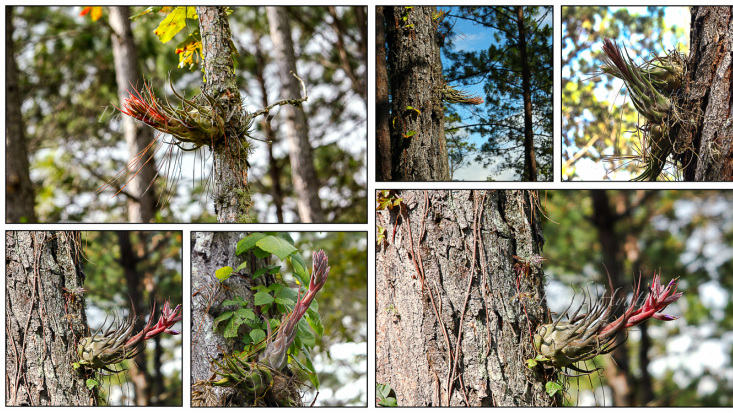 Tillandsia seleriana
Tillandsia seleriana
 Tillandsia seleriana Tillandsia seleriana Of the several bulbous tillandsia speceis, T. seleriana is more widespread and variable than others. It is often called an ant plant. Myrmecophytes (ant plants) are species that provide shelter for the ants that colonize their bulbous shape and can also add some nutritional benefit to the plant. Don't be surprised if you find that ants have invaded your T. seleriana. The published description of Tillandsia seleriana shows it's distribution to be native to Michoacan and Chiapas, Mexico and extending to Honduras. I have actually seen this species as far north as Nayarit, outside of the city of Tepic. T. seleriana also grows in the states of Jalisco and Oaxaca. With such a wide range, there is some variability in the size and shape of this species, as well as the occasional natural hybrid. A smaller form , will bloom at 12 cm while a much larger form can reach 30 to 40 cm. Both forms have the fat bulbous base and produce a rose-pink bloom spike with violet flowers. The entire plant is lepidote (covered with scales or scurf). It is usually found growing in Pine and Oak forests. It is fun to see in habitat as it appears like an abnormal growth on the sides of it's host trees. Enjoy this walk in a T. seleriana forest in Chiapas!
9 Comments
Bob Spivey
7/11/2014 12:53:41 am
Seleriana is one of my favorite Tillandsias. Great pics. and article.
Reply
Pam
7/11/2014 08:16:37 am
Bob, T. seleriana is great. It also easily produces natural hybrids which is an additional bonus.
Reply
Wei
3/28/2018 10:38:02 pm
These are splendid. Thank you for the video. I would have never thought that this species would live in such a semi-dry environment. I thought they all lived in some type of tropical rainforest : ). It'd be a dream to see them first hand in their natural environment.
Reply
5/15/2023 11:44:21 pm
Great picture and article! Thanks for sharing this blog.
Reply
Tillandsia seleriana, also known as the ant plant, is a bulbous tillandsia species found in regions from Mexico to Honduras. It is called an ant plant because it provides shelter and sometimes nutrition to ants that inhabit its bulbous structure. T. seleriana displays variations in size and shape, with forms ranging from 12 cm to 30-40 cm. It produces rose-pink bloom spikes with violet flowers and is typically found in Pine and Oak forests, appearing as an unusual growth on host trees. Visiting a T. seleriana forest in Chiapas, Mexico, provides a unique opportunity to witness the intriguing relationship between this plant and its surrounding ecosystem, showcasing the wonders of nature's symbiotic partnerships.
Reply
10/18/2023 05:45:01 pm
Native to regions spanning from Michoacan and Chiapas, Mexico, to as far south as Honduras, Tillandsia seleriana boasts a broad distribution. Interestingly, I've personally come across this species as far north as Nayarit, just outside the city of Tepic. Its wide range in habitat contributes to variations in size and shape, and occasionally, natural hybrids can be found. Some T. seleriana forms are more petite, blooming at around 12 cm, while others can grow significantly larger, reaching heights of 30 to 40 cm. Regardless of size, both forms share a distinctive fat, bulbous base and produce striking rose-pink bloom spikes adorned with violet flowers. The entire plant is characterized by its lepidote nature, covered in scales or scurf. You'll often find T. seleriana thriving in Pine and Oak forests, where it presents itself like an unusual growth on the sides of its host trees, creating a captivating sight.
Reply
11/27/2023 06:06:07 pm
Ant plants like Tillandsia seleriana are such incredible examples of nature's symbiotic relationships. It's remarkable how they provide both shelter and potential nutritional benefits to the ants that inhabit them. The variation in size and shape within the species adds another layer of wonder to these plants.
Reply
2/16/2024 05:18:05 am
Reply
Leave a Reply. |
 Pamela Koide Hyatt Pamela Koide Hyatt
Horticulturalist & Explorer Specializing in the Genus Tillandsia.
View complete author profile here. Sign Up for Email Updates
Email notification of new blog posts.
Archives
August 2022
Categories
All
|
 RSS Feed
RSS Feed